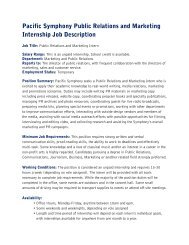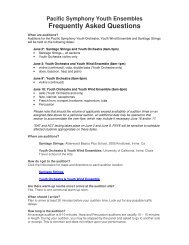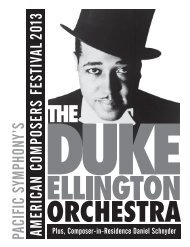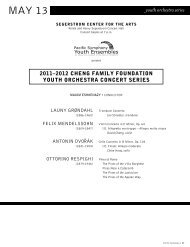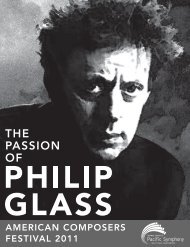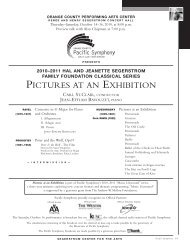Program Notes - Pacific Symphony
Program Notes - Pacific Symphony
Program Notes - Pacific Symphony
Create successful ePaper yourself
Turn your PDF publications into a flip-book with our unique Google optimized e-Paper software.
JUNE 6, 7, 8<br />
classical series<br />
SEGERSTROM CENTER FOR THE ARTS<br />
Renée and Henry Segerstrom Concert Hall<br />
Concerts begin at 8 p.m. Preview talk hosted by Alan Chapman with Joseph Horowitz and Tony Palmer begins at 7 p.m.<br />
presents<br />
2012-2013 HAL & JEANETTE SEGERSTROM<br />
FAMILY FOUNDATION CLASSICAL SERIES<br />
Carl St.Clair • conductor | Joseph Horowitz • artistic adviser<br />
Susana Poretsky • soprano | Hye-Young Kim • piano | Tony Palmer • film director<br />
Tong Wang • choreographer | Members of UC Irvine department of dance<br />
TCHAIKOVSKY (1840-1893)<br />
Excerpts from The Nutcracker, Op. 71<br />
No. 14, Pas de deux<br />
No. 12, Divertissement:<br />
Chocolate (Spanish Dance)<br />
Aly Anderson, Melanie Anderson, Janelle Villanueva,<br />
Tivoli Evans, Ashley LaRosa, Skye Schmidt<br />
Coffee (Arabian Dance)<br />
Karen Wing, Ryan Thomas, Mason Trueblood<br />
Tea (Chinese Dance)<br />
Tracy Shen, Jeremy Zapanta<br />
Trepak (Russian Dance)<br />
Alec Guthrie<br />
Excerpts from Swan Lake, Op. 20<br />
No. 1, Scene<br />
No. 3, Dance of the Swans<br />
Tiffany Arroyo, Tivoli Evans, Tracy Shen, Janelle Villanueva<br />
No. 5, Hungarian Dance (Czardas)<br />
Jennifer Lott, Karen Wing, Alec Guthrie, McCree O’Kelley<br />
No. 6, Spanish Dance<br />
Celeste Lanuza, Jessica Ryan, Jeremy Zapanta<br />
Lullaby in a Storm from Sixteen Songs for Children, Op. 54<br />
Susana Poretsky, soprano • Hye-Young Kim, piano<br />
Stravinsky (1882 - 1971)<br />
Epilogue: Lullaby in the Land of Eternity<br />
from The Fairy’s Kiss<br />
INTERMISSION<br />
Excerpt from Stravinsky: Once at a Border (1982 film)<br />
Directed by Tony Palmer<br />
Stravinsky<br />
The Rite of Spring<br />
PART I: Adoration of the Earth<br />
Introduction<br />
The Augurs of Spring—Dances of the Young Girls<br />
Ritual of Abduction<br />
Spring Rounds<br />
Ritual of the Rival Tribes<br />
Procession of the Sage<br />
The Sage<br />
Dance of the Earth<br />
PART II: The Sacrifice<br />
Introduction<br />
Mystic Circle of the Young Girls<br />
Glorification of the Chosen One<br />
Evocation of the Ancestors<br />
Ritual Action of the Ancestors<br />
Sacrificial Dance (The Chosen One)<br />
Post-concert discussion with Carl St.Clair, Joseph Horowitz and Tony Palmer<br />
The enhancements in this program are<br />
made possible by a generous grant from<br />
The Andrew W. Mellon Foundation.<br />
Generously supported by<br />
The National Endowment for the Arts<br />
<strong>Pacific</strong> <strong>Symphony</strong> Proudly Recognizes its official partners<br />
Official Airline<br />
Official Hotel<br />
Official Television Station<br />
<strong>Pacific</strong> <strong>Symphony</strong> broadcasts are made<br />
possible by a generous grant from<br />
The Saturday, June 8, performance is broadcast live on KUSC, the official classical radio station of <strong>Pacific</strong> <strong>Symphony</strong>. The simultaneous<br />
streaming of this broadcast over the internet at kusc.org is made possible by the generosity of the musicians of <strong>Pacific</strong> <strong>Symphony</strong>.
NOTES<br />
T<br />
onight’s concert celebrates the centenary of Igor Stravinsky’s<br />
The Rite of Spring (Le Sacre du Printemps), premiered<br />
May 29, 1913, at Paris’s Théâtre des Champs-Élysées, with<br />
Pierre Monteux conducting and choreography by Vaslav Nijinsky –<br />
a premiere famous for the riot it provoked. So deafening were the<br />
jeers and catcalls that the dancers could not hear the music: Nijinsky<br />
frantically supervised standing on a backstage chair. That is: the riot<br />
was more a response to what was seen – a ritualized style of “ballet”<br />
as remote from tutus and swans as Stravinsky’s score (had it been<br />
audible) was from Sleeping Beauty or Giselle. It was not until the<br />
following April that Monteux led a concert performance of The Rite<br />
of Spring – and it is as a 35-minute concert piece, sans dance, that<br />
The Rite became a seminal 20th-century masterpiece.<br />
The music’s fascination is multi-faceted. It wears two faces,<br />
diametrically opposed. Let’s call them “Dionysian” and “Apollonian.”<br />
Considered as Dionysian music, The Rite of Spring is visceral, raw,<br />
brutal. Stravinsky called it “scenes from pagan Russia,” the last<br />
being a barbaric Sacrificial Dance depicting a virgin dancing herself<br />
to death. It is pertinent that Nicolas Roerich, the distinguished<br />
Russian painter who contributed to the scenario as well as designing<br />
backcloths and costumes for the first performance, was also an<br />
archeologist with specialized knowledge of the ancient Slavs. Roerich<br />
summarized “the ballet of The Rite of Spring” as “scenes of earthly<br />
joy and celestial triumph as understood by the Slavs.” Stravinsky<br />
once wrote that his first inspiration was envisioning “a solemn pagan<br />
rite: wise elders, seated in a circle, watching a young girl dance<br />
herself to death. They were sacrificing her to propitiate the god of<br />
spring.” A violent primal ceremony.<br />
The Apollonian face of The Rite of Spring, by comparison, is nonviolent:<br />
a pathbreaking compositional study in dissonant harmony<br />
and – especially – complex rhythm. While in recent decades the<br />
conductor/composer Pierre Boulez has influentially propagated this<br />
“objective” reading of the score (buttressed by a formal musical<br />
analysis anticipating the 12-tone procedures of Arnold Schoenberg), it<br />
was Stravinsky himself, in his post-World War I Parisian incarnation,<br />
who initially absorbed The Rite of Spring within a musical aesthetic<br />
promoting order and discipline. In exile from his beloved Russia,<br />
Stravinsky had reinvented himself as an Apollonian Francophile,<br />
rejecting Russian “anarchy” in favor of prevalent French ideals of<br />
aesthetic perfection. In his Poetics of Music, delivered at Harvard in<br />
by joseph horowitz, artistic adviser to pacific symphony<br />
A LISTENING GUIDE<br />
The Rite of Spring begins with a famous solo for high bassoon – a<br />
sinuous, repetitive tune that happens to be the only folk melody<br />
Stravinsky obviously quotes in this score. He took it from a<br />
collection of Lithuanian folk music. It’s a simple tune with a<br />
“compass” – or range – of less than an octave. Generally, the tunes<br />
in The Rite of Spring sound like this one. They’re simple and short<br />
(Stravinsky wrote that he wanted to “tap some unconscious ‘folk’<br />
memory”). They’re often plaintive, with catch-in-the-throat vocal<br />
inflections we associate with untrained peasant singers. Here, the<br />
bassoon tune is impersonally repetitious: primal, primordial.<br />
Stravinsky once said that this first, introductory section of the<br />
ballet was intended to represent “the awakening of nature, the<br />
scratching, gnawing, wiggling of birds and beasts.” The twittering<br />
music gathers detail and momentum; the bassoon melody is<br />
enmeshed or challenged by a multitude of voices, including<br />
screeching birdcalls. It grows cacophonous. The ensuing “Augurs<br />
of Spring” is a pounding dance punctuated by slashing accents.<br />
If the wildness of this music is futuristic and “modern,” its Russian<br />
Romantic roots are equally pertinent. Stravinsky’s techni-colored<br />
evocation of natural sounds, his brilliant realization of festive folk<br />
ritual remind us that The Firebird (1910), with its longer melodies<br />
and lusher harmonies, is the music that made him famous. We’re<br />
also reminded that his teacher was Nikolai Rimsky-Korsakov – who<br />
composed Scheherazade and other magic-carpet journeys to exotic<br />
destinations. The Rite of Spring, to be sure, has a sharper edge –<br />
its aromas are harsher, its rhythms more brutal. But the hurtling<br />
trajectory, however vertiginous, co-exists with pages of picturesque<br />
scenery that should not be overlooked. Nicolas Roerich, the ballet’s<br />
distinguished scenic artist, envisioned “the foot of a sacred hill,<br />
in a lush plain, where Slavonic tribes are gathered together to<br />
celebrate the spring rites.”<br />
The first half of The Rite of Spring — music of communal “mystic<br />
terror,” according to Roerich — is titled “Adoration of the Earth.”<br />
Part two, “The Sacrifice,” starts mysteriously and culminates<br />
brutally with the “Sacrificial Dance” of a “chosen victim” — a<br />
virgin who dances herself to death. Roerich writes of this second<br />
part of the ballet that it “sets a celestial mystery. Young virgins<br />
dance in circles on the sacred hill amid enchanted rocks; then they<br />
choose the victim they intend to honor. In a moment she will dance<br />
before ancients clad in bearskins.”<br />
Few pages in Stravinsky are as hypnotically atmospheric as the<br />
beginning of this second half of The Rite of Spring. (In Fantasia,<br />
Walt Disney’s artists here envisioned primordial underwater<br />
beings.) Heaving, oscillating chords yield sulfurous symphonic<br />
exhalations. Then – slowly, ritualistically, ominously — the<br />
chanting begins<br />
The virgin’s culminating Sacrificial Dance is probably the score’s<br />
most famous episode. Her convulsive death-throes translate into<br />
the most jaggedly irregular rhythmic outbursts Stravinsky had<br />
ever conceived — music that requires a series of shifting meters<br />
(or time-signatures). A cauldron of musical tension — of simple<br />
tunes disturbed by discordant harmonies and shifting pulsation<br />
— is brought to a high boil. She expires to a final savage blast of<br />
percussion.<br />
2 • <strong>Pacific</strong> <strong>Symphony</strong>
NOTES<br />
Piotr Ilyich Tchaikovsky<br />
(1840–1893)<br />
1940, Stravinsky wrote: “I am well aware that there is a point of view<br />
that regards the period in which The Rite of Spring appeared as one<br />
that witnessed a revolution. . . . I deny the validity of that opinion. I<br />
hold that it was wrong to have considered me a revolutionary.” Having<br />
been dispossessed by Lenin’s Bolsheviks, he further “confessed” to be<br />
“completely insensitive to the prestige of revolution.”<br />
Though it seems that both Stravinsky and Roerich had observed a<br />
jarring Russian peasant ritual – the dismembering of the straw effigy<br />
of a virgin – in conceiving The Rite, Stravinsky in Paris recast The<br />
Rite of Spring as kindred to the “neo-classical” works he composed<br />
in France and the United States in the ’20s, ’30s and ’40s. (That<br />
these works were less esteemed than his earlier, more “Russian”<br />
output doubtless contributed to his polemics against Slavic disorder.)<br />
Andersen’s “Ice Maiden,” in which an abandoned babe is kissed by a<br />
fairy; years later, as a young man about to be wed, he dies, reclaimed<br />
by the fairy’s kiss. The ballet is commonly read as an allegory for<br />
Tchaikovsky’s fate: kissed by the muses at birth, doomed to an early<br />
death. The Fairy’s Kiss is Stravinsky revisiting his own childhood,<br />
confiding his emotional roots. In particular, the ballet’s final section<br />
(or “coda”) — “Epilogue: Lullaby in the Land of Eternity” — is a<br />
heart-rending remembrance of childhood innocence. It ends part one of<br />
our concert.<br />
And so this embodiment of “Russia,” linked to the sophisticated and<br />
westernized St. Petersburg in which Stravinsky grew up, connects<br />
to an Apollonian dimension of The Rite of Spring celebrated by such<br />
interpreters as Boulez or Esa-Pekka Salonen, for whom the music<br />
objectively exudes an ingenious compositional panache. For other<br />
interpreters of Stravinsky’s seminal score, its pummeling momentum,<br />
picturesque description, and Dionysian sonic seizures matter most.<br />
WHO WAS STRAVINSKY?<br />
T<br />
onight’s concert juxtaposes two views of Stravinsky’s<br />
relationship with Russia. A larger question, addressed by Tony<br />
Palmer’s superb film documentary (parts of which we see<br />
tonight, and the whole of which is screened at UC Irvine on Friday,<br />
June 7, at 1 p.m. at the Contemporary Arts Center, Claire Trevor<br />
School of the Arts), is: Who was Stravinsky? No other composer<br />
whom we regularly encounter in the concert hall is as hard to place.<br />
And no other composer has shifted identity, posthumously, to the<br />
degree that Stravinsky has since his death in 1971.<br />
For countless musicians, Igor Stravinsky looms as the dominant<br />
20th-century composer of “serious” music. But Stravinsky’s<br />
geographical and stylistic odysseys make him hard to place. Born<br />
in Russia in 1882, he lived abroad beginning in 1920. He became a<br />
French citizen in 1934. He settled in Hollywood in 1940 and became<br />
an American citizen in 1945. He is buried in the Russian corner of a<br />
Venetian cemetery.<br />
Our program tonight explores both faces of The Rite of Spring<br />
– Apollonian and Dionysian – as two faces of the “Russian<br />
Stravinsky.” In effect, we explore two faces of Russia itself.<br />
We begin with Stravinsky’s admiration for his countryman Peter<br />
Ilyich Tchaikovsky – and we hear excerpts from the famous<br />
Tchaikovsky ballets Swan Lake and The Nutcracker as well as<br />
from Stravinsky’s 1928 Tchaikovsky homage The Fairy’s Kiss.<br />
This conjunction of Tchaikovsky with the severities of the later<br />
Stravinsky may seem paradoxical until it is understood that for<br />
Stravinsky Tchaikovsky embodied a cosmopolitan, even “European”<br />
alternative to such “disorderly” Russians as Modest Mussorgsky,<br />
with his “inadequate” technique. Tchaikovsky, by comparison, was<br />
fully schooled, an exquisite craftsman whose genius, for Stravinsky,<br />
resided not in his recklessly impassioned symphonies, but in such<br />
polished cameos as the Nutcracker character pieces we hear.<br />
In The Fairy’s Kiss nearly all the tunes (however distilled and<br />
simplified by Stravinsky) are culled from Tchaikovsky’s songs (of<br />
which we hear the unforgettably poignant “Lullaby in a Storm”)<br />
and piano pieces. In fact, this ballet (little seen today) is arguably<br />
Stravinsky’s most confessional love letter to his homeland, and his<br />
most emotionally naked music. The story adapts Hans Christian<br />
Igor Stravinsky<br />
(1882-1971)<br />
<strong>Pacific</strong> <strong>Symphony</strong> • 3
NOTES<br />
above all, that I was not there to help the new Soviet Union create<br />
its new music.” Craft wrote in his journal from Moscow: “I.S. does<br />
regret his uprooting and exile more than anything else in his life . . .<br />
To be recognized and acclaimed as a Russian in Russia, and to be<br />
performed there, has meant more to him than anything else in the<br />
years I have known him.” All his life Stravinsky thought in Russian<br />
and spoke other languages “in translation”; upon returning from<br />
Russia, he preferred to speak Russian almost exclusively for a period<br />
of months.<br />
But perhaps the most dramatic Stravinsky revisionism is currently<br />
being practiced by Russian performers who are only now reclaiming<br />
their native son. For such leading Soviet-trained instrumentalists as<br />
the conductor Valery Gergiev and pianist Alexander Toradze (our<br />
soloist for next season’s Shostakovich festival), Stravinsky was long<br />
forbidden fruit. Of course, they knew the early Stravinsky – The<br />
Firebird, Petrushka, The Rite of Spring. But the bulk of his output<br />
was unperformable in the Soviet Union. They are performing it now,<br />
belatedly, with the fervor of fresh converts to a cause rightfully their<br />
own. And Stravinsky sounds different — more “Russian” — as they<br />
purvey it. (<strong>Pacific</strong> <strong>Symphony</strong> audiences heard Toradze perform<br />
Stravinsky’s Concerto for Piano and Winds in September 2006.)<br />
For Russian musicians of my acquaintance, Stravinsky is at all<br />
times a Russian composer. The notion of a deracinated neoclassical<br />
Stravinsky — of Stravinsky as Parisian or cosmopolitan,<br />
transcending national identity — is not for them.<br />
Before the turn of the 21st century, the dominant Western tendency<br />
had been to regard Stravinsky as an international modernist.<br />
“Music,” he once wrote, “is given to us to establish an order in<br />
things; to order the chaotic and the personal into something perfectly<br />
controlled, conscious and capable of lasting vitality.” Transcending<br />
politics and race, his idiom — according to a conventional wisdom<br />
his many pronouncements supported — is essentially cosmopolitan,<br />
with strong roots in the French avant-garde. In fact, Stravinsky<br />
sometimes called himself “French.” A 1937 Chicago headline<br />
reported, “Stravinsky, in German, Says He’s French.”<br />
But this Stravinsky wisdom has unraveled. Current scholarship, with<br />
Richard Taruskin of the University of California at Berkeley in the<br />
lead, resituates Stravinsky as “essentially Russian” — aesthetically,<br />
intellectually, musically, personally. What is more, Stravinsky<br />
himself discovered as much upon revisiting his homeland in 1962<br />
at the age of 80. His amanuensis Robert Craft, observing him in<br />
rehearsal with the Moscow National Orchestra, observed: “He is<br />
more buoyant than I have ever seen him.”<br />
At his first Moscow concert, responding to insatiable applause,<br />
Stravinsky returned to the stage in his overcoat to tell the insatiable<br />
audience, “You see a very happy man.” At a gala reception, he rose<br />
to say, “A man has one birthplace, one fatherland, one country — he<br />
can have only one country — and the place of his birth is the most<br />
important factor in his life. I regret that circumstances separated me<br />
from my fatherland, that I did not give birth to my works there and<br />
As a religious anti-Communist expatriate, Stravinsky distanced<br />
himself from Russia and its music as anarchic. And yet he drew<br />
on Russian folk song and ritual. His father had been a leading<br />
opera singer in St. Petersburg. Though he emphatically denied the<br />
possibility of extra-musical content in his “absolute” compositions,<br />
his grounding was not in symphony but in the theater, including the<br />
operas and ballets of Tchaikovsky. His fascination with ritual and<br />
physical movement were lifelong. What George Balanchine termed<br />
the “dance element” in Stravinsky is a prevailing feature.<br />
It would take a psychiatrist to fathom Stravinsky’s various exercises in<br />
self-denial. Taruskin has called Stravinsky an inveterate “liar” who in<br />
his various self-misrepresentations revealed “an astonishing, chronic<br />
sense of cultural inferiority.” One does not have to fully agree with this<br />
combative assessment to recognize that Stravinsky’s traumatic loss<br />
of his Russian homeland necessitated a heroic act of adaptation – of<br />
identity adjustment – which can never fully be sorted out.<br />
stay connected with pacific symphony online!<br />
<strong>Pacific</strong><br />
<strong>Symphony</strong><br />
Facebook Twitter Tumblr YouTube Mobile App<br />
www.<strong>Pacific</strong><strong>Symphony</strong>.org<br />
4 • <strong>Pacific</strong> <strong>Symphony</strong>
Don’t miss this complement to tonight’s performance!<br />
“A ‘Rite of Spring’ for the 21st Century”<br />
A UC Irvine Department of Dance collaboration directed by<br />
John Crawford, featuring choreography by Lisa Naugle, Chad<br />
Michael Hall and Jodie Gates.<br />
This Free Event takes place in the Samueli Theater starting<br />
at 7 p.m. before tonight’s concert and again at approximately<br />
10:15 p.m. after the concert.<br />
Part media installation and part dance concert, The Sacre Project<br />
re-envisions The Rite of Spring as a radically deconstructed<br />
performance event. The digital media installation remixes sections<br />
of The Rite of Spring, presented with small groups of dancers<br />
in “pods” arranged around the Samueli Theater. The audience<br />
is encouraged to walk through the room to watch and listen to<br />
the piece on their own individual terms. The dancers gradually<br />
transform the space from this unstructured experience to a<br />
circular performance environment, where the event concludes<br />
with the sacrificial dance from The Rite of Spring on the central<br />
platform.<br />
Igor Stravinsky’s iconic score for The Rite of Spring was first<br />
performed in 1913 with choreography by Vaslav Nijinsky and<br />
scenic design by Nicholas Roerich. In 2013, The Sacre Project<br />
uses new dance material created by choreographers Lisa<br />
Naugle, Chad Michael Hall and Jodie Gates, processed and<br />
interpreted through digital projections and live video capture by<br />
John Crawford to examine notions of memory and embodiment.<br />
The Sacre Project situates dance in a non-traditional setting,<br />
incorporating advanced visual and sonic environments that<br />
interact with choreography and dancers to evoke an uneasy<br />
marriage between media installation and theatrical performance.<br />
The Sacre Project is produced by Claire Trevor School of the<br />
Arts at University of California, Irvine, in cooperation with <strong>Pacific</strong><br />
<strong>Symphony</strong>. “It’s truly a collaborative project” says director John<br />
Crawford. “While our school’s choreographers, designers, dancers<br />
and musicians are digging deeply into the heritage of this hugely<br />
influential work, our guiding vision is to create a new work that<br />
integrates digital media with the performing arts to embody a<br />
Rite of Spring for the 21st century.”
6 • <strong>Pacific</strong> <strong>Symphony</strong>
<strong>Pacific</strong> <strong>Symphony</strong> • 7
CARL<br />
meet the music director<br />
I<br />
n 2012-13, Music Director Carl St.Clair celebrates his 23rd season with <strong>Pacific</strong> <strong>Symphony</strong>.<br />
During his tenure, St.Clair has become widely recognized for his musically distinguished<br />
performances, his commitment to building outstanding educational programs and his<br />
innovative approaches to programming. St.Clair’s lengthy history with the <strong>Symphony</strong> solidifies<br />
the strong relationship he has forged with the musicians and the community. His continuing role<br />
also lends stability to the organization and continuity to his vision for the <strong>Symphony</strong>’s future.<br />
Few orchestras can claim such rapid artistic development as <strong>Pacific</strong> <strong>Symphony</strong> — the largest<br />
orchestra formed in the United States in the last 40 years — due in large part to St.Clair’s<br />
leadership.<br />
The 2012-13 season continues the three-year opera-vocal initiative, “Symphonic Voices,”<br />
with a semi-staged production of Puccini’s Tosca, and a “Music Unwound” concert featuring<br />
Soprano Ute Lemper singing Kurt Weill’s Seven Deadly Sins as well as songs by George<br />
Gershwin and Edith Piaf. Two additional “Music Unwound” concerts highlighted by multimedia<br />
elements and innovative formats include Mozart’s Requiem and the 100th anniversary of<br />
Stravinsky’s Rite of Spring. The 13th American Composers Festival is a jazz celebration<br />
featuring the Duke Ellington Orchestra and composer Daniel Schnyder.<br />
In 2008-09, St.Clair celebrated the milestone 30th anniversary of <strong>Pacific</strong> <strong>Symphony</strong>. In 2006-07,<br />
he led the orchestra’s historic move into its home in the Renée and Henry Segerstrom Concert Hall<br />
at Segerstrom Center for the Arts. The move came on the heels of the landmark 2005-06 season<br />
that included St.Clair leading the <strong>Symphony</strong> on its first European tour — nine cities in three<br />
countries playing before capacity houses and receiving extraordinary responses. The <strong>Symphony</strong><br />
received rave reviews from Europe’s classical music critics — 22 reviews in total.<br />
From 2008 to 2010, St.Clair was general music director for the Komische Oper in Berlin,<br />
where he led successful new productions such as La Traviata (directed by Hans Neuenfels). He<br />
also served as general music director and chief conductor of the German National Theater and<br />
Staatskapelle (GNTS) in Weimar, Germany, where he recently led Wagner’s Ring Cycle to great<br />
critical acclaim. St.Clair was the first non-European to hold his position at the GNTS; the role<br />
also gave him the distinction of simultaneously leading one of the newest orchestras in America<br />
and one of the oldest orchestras in Europe.<br />
Carl St.Clair<br />
William J. Gillespie<br />
Music Director Chair<br />
St.Clair’s international career has him conducting abroad numerous months a year, and he has<br />
appeared with orchestras throughout the world. He was the principal guest conductor of the<br />
Radio Sinfonieorchester Stuttgart from 1998-2004, where he successfully completed a threeyear<br />
recording project of the Villa-Lobos symphonies. He has also appeared with orchestras<br />
in Israel, Hong Kong, Japan, Australia, New Zealand, and South America, and summer<br />
festivals worldwide. St.Clair’s commitment to the development and performance of new works<br />
by American composers is evident in the wealth of commissions and recordings by <strong>Pacific</strong><br />
<strong>Symphony</strong>. St.Clair has led the orchestra in numerous critically acclaimed albums including two<br />
piano concertos of Lukas Foss on the harmonia mundi label. Under his guidance, the orchestra<br />
has commissioned works which later became recordings, including Philip Glass’ The Passion of<br />
Ramakrishna, Richard Danielpour’s An American Requiem on Reference Recordings and Elliot<br />
Goldenthal’s Fire Water Paper: A Vietnam Oratorio on Sony Classical with cellist Yo-Yo Ma.<br />
Other composers commissioned by St.Clair and <strong>Pacific</strong> <strong>Symphony</strong> include William Bolcom,<br />
Philip Glass, Zhou Long, Tobias Picker, Frank Ticheli and Chen Yi, Curt Cacioppo, Stephen<br />
Scott, Jim Self (the <strong>Symphony</strong>’s principal tubist), Christopher Theofandis and James Newton<br />
Howard.<br />
In North America, St.Clair has led the Boston <strong>Symphony</strong> Orchestra, (where he served as<br />
assistant conductor for several years), New York Philharmonic, Philadelphia Orchestra, Los<br />
Angeles Philharmonic and the San Francisco, Seattle, Detroit, Atlanta, Houston, Indianapolis,<br />
Montreal, Toronto and Vancouver symphonies, among many.<br />
A strong advocate of music education for all ages, St.Clair has been essential to the creation<br />
and implementation of the symphony education programs including Classical Connections,<br />
arts-X-press and Class Act.<br />
8 • <strong>Pacific</strong> <strong>Symphony</strong>
GUESTS<br />
Joseph Horowitz<br />
Artistic adviser<br />
meet the guest artists<br />
J<br />
oseph Horowitz, <strong>Pacific</strong> <strong>Symphony</strong>’s artistic adviser since 1999, has long been a pioneer<br />
in thematic, interdisciplinary classical music programming, beginning with his tenure as<br />
artistic adviser for the annual Schubertiade at New York’s 92nd Street Y. As executive<br />
director of the Brooklyn Philharmonic Orchestra, he received national attention for “the<br />
Russian Stravinsky,” “Dvořák and America,” “American Transcendentalists,” “Flamenco” and<br />
other festivals that explored the folk roots of concert works and the quest for national identity<br />
through the arts. Now an artistic adviser to various American orchestras, he has created more<br />
than three dozen interdisciplinary music festivals since 1985. He is also the founding artistic<br />
director of Washington, D.C.’s path-breaking chamber orchestra, PostClassical Ensemble, in<br />
which capacity he has produced two DVDs for Naxos that feature classical documentary films<br />
with newly recorded soundtracks. He is also the award-winning author of eight books that<br />
address the institutional history of classical music in the United States. Both Classical Music<br />
in America: A History (2005) and Artists in Exile (2008) were named best books of the year by<br />
The Economist. The Czech Parliament has awarded him a certificate of appreciation; he is also<br />
the recipient of a Guggenheim Fellowship and fellowships from the National Endowment for the<br />
Humanities and Columbia University.<br />
H<br />
ailed by the San Francisco Chronicle for having a voice of “extraordinary passion<br />
and power” and her “grand but emotionally transparent” characterizations, Susana<br />
Poretsky began the 2012-13 season singing Verdi’s Requiem with the Atlanta<br />
<strong>Symphony</strong> Orchestra in their program of the Defiant Requiem: Verdi at Terezin. Last season,<br />
she sang Ravel’s Chansons Madécasses and Beethoven’s <strong>Symphony</strong> No. 9 with <strong>Pacific</strong><br />
<strong>Symphony</strong> as well as Verdi’s Requiem with the Reno Philharmonic.<br />
Following a triumph at Plácido Domingo’s Operalia competition in 1998, she was invited to<br />
sing a gala concert with the tenor in Japan and subsequently, Suzuki in Madama Butterfly<br />
with Los Angeles Opera. Among the mezzo-soprano’s other recent engagements in America<br />
are Pauline in Pique Dame with both Los Angeles Opera and Washington National Opera, the<br />
title role in Carmen with the Fort Worth Opera; Fenena in Nabucco, Margret in Wozzeck and<br />
Anna in Maria Stuarda with San Diego Opera; and concert performances of Rimsky-Korsakov’s<br />
Mlada with Michael Tilson Thomas and the San Francisco <strong>Symphony</strong>.<br />
Susana Poretsky<br />
soprano<br />
In Europe, Poretsky was recently heard in performances of Francesca Zambello’s production<br />
of Prokofiev’s War and Peace at the Paris Opera (released on DVD), as Adalgisa in Norma and<br />
Charlotte in Massenet’s Werther at the Royal Opera in Stockholm, Fenena in Nabucco at the<br />
Arena di Verona and the title role in Bizet’s Carmen with Theatre de la Monnaie in Brussels<br />
under the baton of Antonio Pappano, after already having sung the same role in Japan and in<br />
South Africa. She made her La Scala debut in Ariadne auf Naxos under Giuseppe Sinopoli’s<br />
baton and at the Mannheim National Theater as Marina Mnishek in Boris Godunov.<br />
H<br />
ye-Young Kim is an active collaborative pianist and coach in a wide variety of<br />
repertoire and ensembles. She has performed on many stages including Centennial Hall<br />
in South Korea, Suntory Hall in Japan and National Concert Hall in Taiwan. She has<br />
served as a collaborative pianist and an instrumental and vocal coach for <strong>Pacific</strong> <strong>Symphony</strong>,<br />
USC Chamber Choir, USC Opera, UCLA Opera, Songfest and American Institute of Musical<br />
Studies in Graz, Austria. Her performances have appeared on numerous radio broadcasts for<br />
PBC, KBS and MBC in Korea, Taiwanese radio, and KUSC and KMZT in Los Angeles.<br />
She received her bachelor of music degree in piano performance from Kyunpook National<br />
University in South Korea, and her master and doctor of musical arts degrees from the<br />
University of Southern California in keyboard collaborative arts and was awarded the<br />
distinguished Gwendolyn Koldofsky Scholarship Award for five consecutive years. Kim is<br />
currently an adjunct faculty member at the Chapman University Hall–Musco Conservatory of<br />
Music.<br />
Hye-Young Kim<br />
piano<br />
<strong>Pacific</strong> <strong>Symphony</strong> • 9
GUESTS<br />
Tony Palmer<br />
film director<br />
Tong Wang<br />
choreographer<br />
meet the guest artists<br />
T<br />
ony Palmer’s vast filmography of over 100 films ranges from early works with The<br />
Beatles, Cream, Jimi Hendrix and Frank Zappa (200 Motels), to the famous portraits<br />
with and about Walton, Britten, Stravinsky, Maria Callas, John Osborne, Leonard<br />
Cohen (Bird on a Wire), Margot Fonteyn and Menuhin. His 7-hour, 45-minute film on Wagner,<br />
starring Richard Burton, Laurence Olivier and Vanessa Redgrave, was described by the Los<br />
Angeles Times as “one of the most beautiful films ever made.” Among over 40 international<br />
prizes for his work are 12 gold medals at the New York Film & Television Festival, as well<br />
as numerous BAFTA (British Academy of Film & Television), Emmy & Grierson nominations<br />
and awards. An honorary citizen of both Athens and New Orleans, a Fellow of the Royal<br />
Geographical Society & DLitt., he is the only person to have won the Prix Italia twice.<br />
His 1982 film, Stravinsky: Once at a Border, won the Special Jury Prize at the San Francisco<br />
Film Festival and was lauded a “superb documentary which achieved miracles of compression,<br />
lucidity and respect” by The New York Times. His other award-winning films include Callas,<br />
Wagner, A Time There Was, Peter Sellers, All You Need is Love, At the Haunted End of the Day,<br />
profiles on Liberace, Hugh Hefner and Michael Crawford, God Rot Tunbridge Wells, Menuhin,<br />
Testimony, The <strong>Symphony</strong> of Sorrowful songs, England My England, Brahms and the Little<br />
Singing Girls, Hero: The Story of Bobby Moore, Toward the Unknown Region – Malcolm Arnold,<br />
Margot, The Harvest of Sorrow and Ivry Gitlis, among others.<br />
F<br />
ollowing a successful career as a principal artist, Tong Wang has continued to devote his<br />
talents to the field of dance as a choreographer, dance professor and master teacher. In<br />
recent years, Wang’s creative works have continued to become notable internationally.<br />
While his choreographic works have received high praise from the nationally ranked dance<br />
departments of University of Utah, Butler University and University of California, Irvine<br />
(UCI), his work has also been performed by companies such as Ballet West, China Military<br />
Dance Ensemble and Ballet Arkansas. His work Chase has been performed in the United States<br />
and China numerous times and was broadcast by China Central Television Station. One of his<br />
most recent works, Qiu Yie, won him an Outstanding Choreographer Award at the 2012 Youth<br />
America Grand Prix, the largest ballet competition in the world.<br />
After graduating with honors from the prestigious Beijing Dance Academy in 1986, Wang<br />
performed as a principal dancer with companies such as Shanghai Ballet, Tulsa Ballet Theatre,<br />
Dayton Ballet, Colorado Ballet and, most recently, Ballet West. While dancing professionally,<br />
Wang completed his B.F.A. and M.F.A. degrees in ballet teaching and choreography with<br />
the University of Utah ballet department and also worked as a guest faculty member from<br />
2000-2005. From 2005-2011, Wang served as assistant professor of dance at Wright State<br />
University and Butler University. In Fall 2011, Wang joined the distinguished dance department<br />
of UCI.<br />
T<br />
he University of California, Irvine Department of Dance in the Claire Trevor School of<br />
the Arts is one of the largest dance programs in the nation. The department has achieved<br />
world-wide recognition for educating dancers toward a professional career in dance.<br />
The renowned faculty offer dancers a challenging curriculum and an inspiring atmosphere in<br />
which performance opportunities, creative projects and theoretical studies complement and<br />
reinforce each other. Students engage with faculty in a wide range of research areas to create<br />
a highly active environment where artistic and scholarly work is experienced from experiential,<br />
historical, technological, philosophical and scientific perspectives.<br />
UC Irvine<br />
Department of Dance<br />
10 • <strong>Pacific</strong> <strong>Symphony</strong>
ABOUT<br />
pacific symphony<br />
P<br />
acific <strong>Symphony</strong>, celebrating its 34th season in 2012-13, is led by Music Director Carl<br />
St.Clair, who marks his 23rd season with the orchestra. The largest orchestra formed<br />
in the U.S. in the last 40 years, the <strong>Symphony</strong> is recognized as an outstanding ensemble<br />
making strides on both the national and international scene, as well as in its own community<br />
of Orange County. Presenting more than 100 concerts a year and a rich array of education<br />
and community programs, the <strong>Symphony</strong> reaches more than 275,000 residents—from school<br />
children to senior citizens.<br />
The <strong>Symphony</strong> offers repertoire ranging from the great orchestral masterworks to music from<br />
today’s most prominent composers, highlighted by the annual American Composers Festival and<br />
a series of multi-media concerts called Music Unwound. Last season, the <strong>Symphony</strong> launched<br />
the highly successful opera and vocal initiative, Symphonic Voices. It also offers a popular Pops<br />
season, enhanced by state-of-the-art video and sound, led by Principal Pops Conductor Richard<br />
Kaufman, who celebrates 22 years with the orchestra in 2013-14. Each <strong>Symphony</strong> season also<br />
includes Café Ludwig, a chamber music series, and Classical Connections, an orchestral matinee<br />
series offering rich explorations of selected works led by St.Clair. Assistant Conductor Alejandro<br />
Gutiérrez began serving this season as music director of <strong>Pacific</strong> <strong>Symphony</strong> Youth Orchestra and<br />
also leads Family and Youth Concerts. New in 2013, <strong>Pacific</strong> <strong>Symphony</strong> is collaborating with a<br />
number of modern musicians and artists and hosting the Wavelength Festival of Music at the<br />
<strong>Pacific</strong> Amphitheatre in August.<br />
Founded in 1978 as a collaboration between California State University, Fullerton (CSUF),<br />
and North Orange County community leaders led by Marcy Mulville, the <strong>Symphony</strong> performed<br />
its first concerts at Fullerton’s Plummer Auditorium as the Fullerton Chamber Orchestra, under<br />
the baton of then-CSUF orchestra conductor Keith Clark. The following season, the <strong>Symphony</strong><br />
expanded its size, changed its name to <strong>Pacific</strong> <strong>Symphony</strong> Orchestra and moved to Knott’s<br />
Berry Farm. The subsequent six seasons, led by Clark, took place at Santa Ana High School<br />
auditorium, where the <strong>Symphony</strong> also made its first six acclaimed recordings. In September<br />
1986, the <strong>Symphony</strong> moved to the new Orange County Performing Arts Center, where Clark<br />
served as music director until 1990 and since 1987, the orchestra has additionally presented a<br />
summer outdoor series at Irvine’s Verizon Wireless Amphitheater. In 2006-07, the <strong>Symphony</strong><br />
moved into the Renée and Henry Segerstrom Concert Hall, with striking architecture by Cesar<br />
Pelli and acoustics by Russell Johnson—and in 2008, inaugurated the hall’s critically acclaimed<br />
4,322-pipe William J. Gillespie Concert Organ. The orchestra embarked on its first European<br />
tour in 2006, performing in nine cities in three countries.<br />
The 2013-14 season will see the continuation of a recent slate of recordings that began with two<br />
newly released CDs in 2012-13 featuring two of today’s leading composers, Philip Glass’ The<br />
Passion of Ramakrishna and Michael Daugherty’s Mount Rushmore, both the result of works<br />
commissioned and performed by the <strong>Symphony</strong>, with three more recordings due to be released<br />
over the next few years. These feature the music of <strong>Symphony</strong>-commissioned works by William<br />
Bolcom, Songs of Lorca and Prometheus, James Newton Howard’s I Would Plant a Tree and<br />
Richard Danielpour’s Toward a Season of Peace. The <strong>Symphony</strong> has also commissioned and<br />
recorded An American Requiem, by Danielpour and Elliot Goldenthal’s Fire Water Paper:<br />
A Vietnam Oratorio with Yo-Yo Ma. Other recordings have included collaborations with<br />
such composers as Lucas Foss and Toru Takemitsu. It has also commissioned such leading<br />
composers as Paul Chihara, Daniel Catán, William Kraft, Ana Lara, Tobias Picker, Christopher<br />
Theofanidis, Frank Ticheli and Chen Yi.<br />
PACIFIC SYMPHONY<br />
In both 2005 and 2010, the <strong>Symphony</strong> received the prestigious ASCAP Award for<br />
Adventuresome <strong>Program</strong>ming. Also in 2010, a study by the League of American Orchestras,<br />
“Fearless Journeys,” included the <strong>Symphony</strong> as one of the country’s five most innovative<br />
orchestras. The <strong>Symphony</strong>’s award-winning education programs benefit from the vision of<br />
St.Clair and are designed to integrate the orchestra and its music into the community in ways<br />
that stimulate all ages. The <strong>Symphony</strong>’s Class Act program has been honored as one of nine<br />
exemplary orchestra education programs by the National Endowment for the Arts and the<br />
League of American Orchestras. The list of instrumental training initiatives includes <strong>Pacific</strong><br />
<strong>Symphony</strong> Youth Orchestra, <strong>Pacific</strong> <strong>Symphony</strong> Youth Wind Ensemble and <strong>Pacific</strong> <strong>Symphony</strong><br />
Santiago Strings as well as Santa Ana Strings.<br />
<strong>Pacific</strong> <strong>Symphony</strong> • 11
MEET<br />
the orchestra<br />
CARL ST.CLAIR • MUSIC DIRECTOR<br />
William J. Gillespie Music Director Chair<br />
RICHARD KAUFMAN • PRINCIPAL POPS CONDUCTOR<br />
Hal and Jeanette Segerstrom Family Foundation Principal Pops Conductor Chair<br />
MAXIM ESHKENAZY • ASSISTANT CONDUCTOR<br />
Alejandro Gutiérrez • ASSISTANT CONDUCTOR<br />
Mary E. Moore Family Assistant Conductor Chair<br />
FIRST VIOLIN<br />
Raymond Kobler<br />
Concertmaster,<br />
Eleanor and Michael Gordon Chair<br />
Paul Manaster<br />
Associate Concertmaster<br />
Jeanne Skrocki 20<br />
Assistant Concertmaster<br />
Nancy Coade Eldridge<br />
Christine Frank<br />
Kimiyo Takeya<br />
Ayako Sugaya<br />
Ann Shiau Tenney<br />
Maia Jasper<br />
Robert Schumitzky<br />
Agnes Gottschewski<br />
Dana Freeman<br />
Grace Oh<br />
Jean Kim<br />
Angel Liu<br />
Marisa Sorajja<br />
Second Violin<br />
Bridget Dolkas*<br />
Jessica Guideri**<br />
Yen-Ping Lai<br />
Yu-Tong Sharp<br />
Ako Kojian<br />
Ovsep Ketendjian<br />
Linda Owen<br />
Phil Luna<br />
MarlaJoy Weisshaar<br />
Robin Sandusky 30<br />
Alice Miller-Wrate<br />
Shelly Shi<br />
10<br />
Viola<br />
Robert Becker* 30<br />
Catherine and James Emmi Chair<br />
Meredith Crawford**<br />
Carolyn Riley<br />
John Acevedo<br />
Erik Rynearson<br />
Luke Maurer<br />
Julia Staudhammer 20<br />
Joseph Wen-Xiang Zhang<br />
Pamela Jacobson<br />
Adam Neeley<br />
Cheryl Gates 10<br />
Margaret Henken<br />
Cello<br />
Timothy Landauer* 20<br />
Kevin Plunkett**<br />
John Acosta<br />
Robert Vos<br />
László Mezö<br />
Ian McKinnell<br />
M. Andrew Honea<br />
Waldemar de Almeida<br />
Jennifer Goss<br />
Rudolph Stein<br />
Bass<br />
Steven Edelman*<br />
Douglas Basye**<br />
Christian Kollgaard<br />
David Parmeter†<br />
Paul Zibits<br />
David Black<br />
Andrew Bumatay 30<br />
Constance Deeter<br />
Flute<br />
Benjamin Smolen*<br />
Valerie and Hans Imhof Chair<br />
Sharon O’Connor<br />
Cynthia Ellis<br />
Piccolo<br />
Cynthia Ellis<br />
Oboe<br />
Jessica Pearlman*<br />
Suzanne R. Chonette Chair<br />
Deborah Shidler<br />
English Horn<br />
Lelie Resnick<br />
Clarinet<br />
Benjamin Lulich*<br />
The Hanson Family Foundation Chair<br />
David Chang<br />
Bass Clarinet<br />
Joshua Ranz<br />
Bassoon<br />
Rose Corrigan*<br />
Elliott Moreau<br />
Andrew Klein<br />
Allen Savedoff<br />
Contrabassoon<br />
Allen Savedoff<br />
French Horn<br />
Keith Popejoy*<br />
Mark Adams<br />
James Taylor**<br />
Russell Dicey 30<br />
Trumpet<br />
Barry Perkins*<br />
Tony Ellis<br />
David Wailes<br />
Trombone<br />
Michael Hoffman*<br />
David Stetson<br />
Bass Trombone<br />
Robert Sanders<br />
TUBA<br />
James Self*<br />
Timpani<br />
Todd Miller*<br />
Percussion<br />
Robert A. Slack*<br />
Cliff Hulling<br />
Harp<br />
Mindy Ball*<br />
Michelle Temple<br />
Piano•Celeste<br />
Sandra Matthews*<br />
Personnel Manager<br />
Paul Zibits<br />
Librarians<br />
Russell Dicey<br />
Brent Anderson<br />
Production<br />
Stage Manager<br />
Will Hunter<br />
Assistant<br />
Stage Manager<br />
William Pruett<br />
* Principal<br />
** Assistant Principal<br />
† On Leave<br />
The musicians of <strong>Pacific</strong> <strong>Symphony</strong> are members of the American Federation of Musicians, Local 7.<br />
Celebrating 30, 20 or 10 years with<br />
<strong>Pacific</strong> <strong>Symphony</strong> this season.<br />
12 • <strong>Pacific</strong> <strong>Symphony</strong>
Inside & Out<br />
plazacast and community celebration<br />
Schedule of Events: June 8<br />
All activities take place on the Plaza at Segerstrom Center for the Arts<br />
unless otherwise indicated.<br />
5 p.m.: Food trucks and activity booths open<br />
Live movement and art workshops presented by The Drawing Board, The<br />
ReRite of Spring iPad remixes, an interactive dance booth in the concert hall<br />
lobby and more!<br />
5:10-5:25 p.m.: Fourtunates Woodwind Quartet<br />
A classical quartet of flute, oboe, clarinet and bassoon from members of<br />
<strong>Pacific</strong> <strong>Symphony</strong> Youth Ensembles.<br />
5:30-5:50 p.m.: Laguna Flutes<br />
A flute ensemble for the 21st century, made up of 21 flutes, led by <strong>Pacific</strong><br />
<strong>Symphony</strong>’s principal piccolo Cynthia Ellis. Instrumentation includes piccolo,<br />
C flutes, 5 alto flutes and 2 bass flutes.<br />
6-6:35 p.m.: Helix Collective<br />
With their out-of-the-box mix of classical, world and rock ‘n’ roll, Helix<br />
Collective turns the Plazacast into a classical dance club. The group provides<br />
quickie dance lessons during the show including salsa, Bollywood, bluegrass<br />
and klezmer. It’s a lightning-speed trip around the world, so wear your<br />
dancing shoes and get ready to party!<br />
6:45-7 p.m.: Santa Ana Strings<br />
Come hear the Santa Ana Strings perform for their third performance this<br />
season! Watch these 4th- and 5th-grade violin students perform with the<br />
assistance of <strong>Pacific</strong> <strong>Symphony</strong> musicians. This after-school program is a<br />
partnership between <strong>Pacific</strong> <strong>Symphony</strong>, THINK Together and Santa Ana<br />
Unified School District.<br />
7 p.m.: The Sacre Project (samueli theater)<br />
The Sacre Project, presented by UC Irvine’s Claire Trevor School of the<br />
Arts in collaboration with <strong>Pacific</strong> <strong>Symphony</strong>, is a part media installation,<br />
part dance performance that re-envisions The Rite of Spring as a radically<br />
deconstructed performance event. Directed by John Crawford, the<br />
performance includes new dance material created by three choreographers.<br />
7:30 p.m.: Preview Talk with Rich Capparela<br />
8 p.m.: The Rite of Spring Concert begins<br />
Turn to page 1 for program information.<br />
intermission:<br />
Live interviews conducted by host Rich Capparela<br />
10:15 p.m.: Concert Talk-Back with Music Director Carl St.Clair, Artistic Adviser<br />
Joseph Horowitz and film director Tony Palmer (segerstrom concert hall)<br />
10:15 p.m.: The Sacre Project (samueli theater)<br />
<strong>Pacific</strong> <strong>Symphony</strong> • 13





